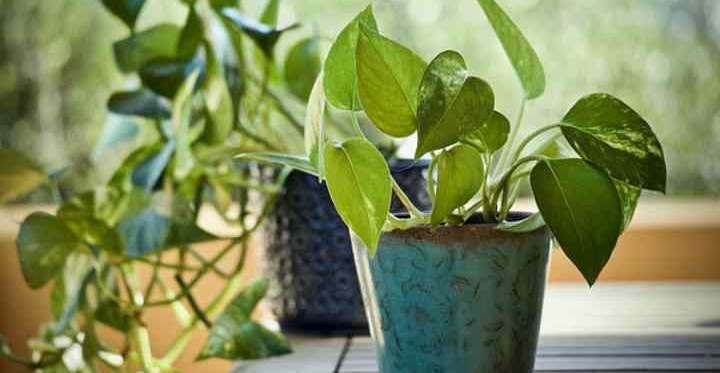Pothos (Epipremnum aureum) is an easy-to-care-for houseplant that brightens up any indoor environment and adds life. The long trailing stems and vivid green heart-shaped leaves of a pothos plant distinguish it. These vine indoors plants only need to be watered occasionally and can survive in low-light environments. Variegated leaves in gold-yellow, creamy-white, light green, jade, neon, and marble are common colors for many popular types of pothos.
How to care for pothos plants: When the soil is partially dry, water pothos when it is in bright, indirect sunlight and grow in a well-draining potting mix. Keep humidity levels high while temperatures are between 65°F and 75°F (18°C and 23°C). To encourage bushy growth, fertilize monthly and trim every so often.
Devil’s ivy, taro vine, marble queen, ivy arum, and money plant are some of the other names for Pothos. Since it is on the list of best plants that clean room air, growing pothos indoors may help improve air quality.
The brilliant foliage and long dangling stems of devil’s ivy appeal to most people. Pothos thrives in bright as well as dimly-lit rooms, offices, and under fluorescent light. They are also great bedroom plants because they can survive in low light.
Why do pothos plants have yellow leaves? Too much moisture is usually indicated by yellowing of the leaves on a pothos plant. The roots may be affected by over-watering or wet soggy soil, resulting in yellowing of the leaves. Always make sure that the soil dries out somewhat between watering to avoid yellowing leaves.
How often to water pothos Several plant enthusiasts have this concern. Only when the top 1″ (2.5 cm) of soil has dried should you water a devil’s ivy plant. To look after a pothos properly, it’s preferable to water less rather than more. As a result, don’t water pothos on a regular basis according to a set schedule. Only water the potting mix when it is partially dry before testing for moisture.
What is Pothos Vine?
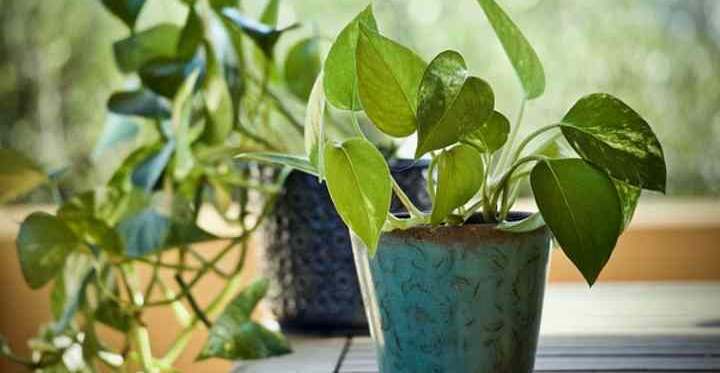
Pothos (Epipremnum aureum) is a type of flowering vine in the Araceae family that blooms gold. It’s thrive in warm temperatures and high humidity, which are common in tropical countries. Pothos flowers indoors infrequently, if at all, in its natural environment.
Pothos plants are identified by leaves that form a heart shape. Indoors, heart-shaped leaves with long trailing stems may grow up to 10 feet (3 meters) long. Regular pruning may help the plant foliage grow bushier by reducing growth. With its dangling bright foliage, Pothos makes a fantastic indoor hanging basket plant. You can even teach pothos to climb a moss pole or similar support by vertically training it.
Pothos vs. Philodendron

Heartleaf Philodendron (Philodendron hederaceum) is seen in the photograph. Varieties of pothos vines are incorrectly labeled as philodendron in plant shops. These vining plants have heart-shaped leaves and trailing stems that are quite long. The leaves of pothos plants are bigger and have a waxy feel, so it’s easy to tell them apart from philodendron plants.
Types of Pothos Vine Plants
Let’s take a look at some identifying characteristics of popular types of pothos before we discuss how to care for pothos plants.
Neon pothos—Bright neon-green leaves characterize this trailing houseplant vine. The cheerful foliage looks good draped from a shelf or hanging in a basket, brightening up a gloomy corner.

Epipremnum aureum ‘ Neon Photos’
Golden pothos (Epipremnum aureum) —Golden pothos is one of the most popular indoor plants because it requires little care. The glossy green leaf color contrasts sharply with the large heart leaves’ bright yellow variegation.
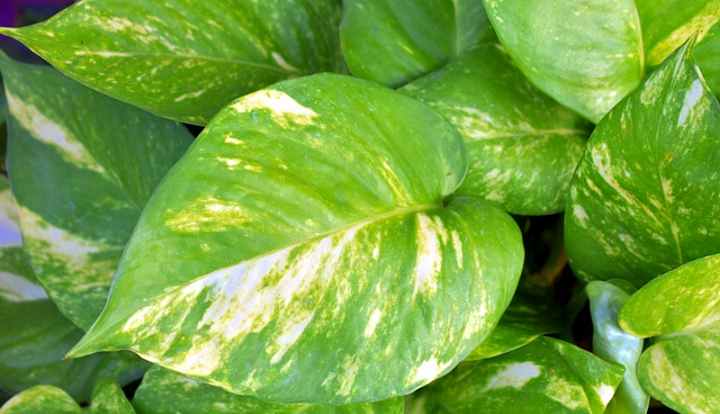
Epipremnum aureum (Golden Pothos or Devils Ivy) is a popular name for this plant.
Marble queen pothos—The plant has a bright appearance because of its variegated leaves with green and cream-white colors. The leathery leaves of this hardy trailing houseplant grow equally well in bright as in low light, and it thrives indoors.

Pothos Epipremnum aureum (marble queen pothos)
Jade pothos—Like all types of pothos, this devil’s ivy variation has solid green leaves that trail. Pothos plants are frequently mistaken for philodendrons because of their resemblance to heartleaf philodendron.
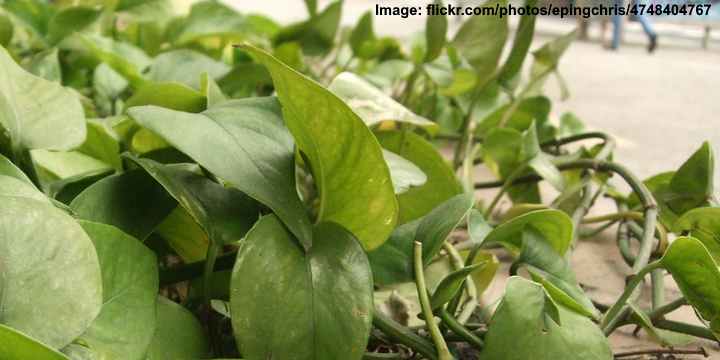
Epipremnum aureum ‘jade pothos’
Silver pothos, glacier pothos, and pearls and jade pothos are some of the most popular varieties of pothos.
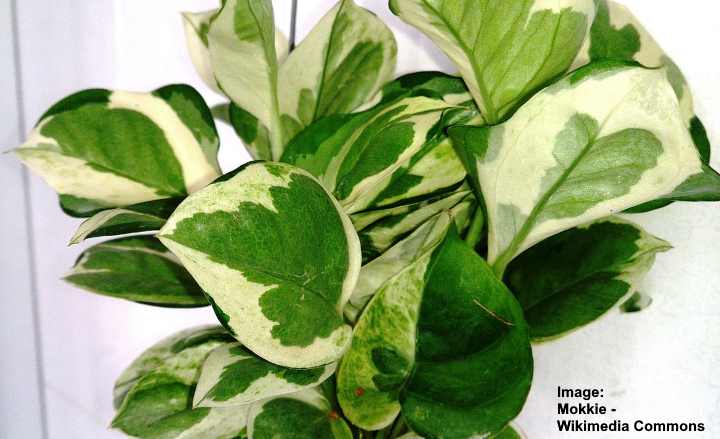
Epipremnum aureum, sometimes known as Pearls and Jade
How to Care for Pothos—Growing Pothos at Home
Despite the fact that devil’s ivy is a simple houseplant to cultivate, there are a few things that you must understand. Silver pothos plants, or any other kind of plant, have the following three essential care requirements:
- Proper soil moisture
- High humidity
- Adequate light
Pothos Light Requirements
In bright light to partial shade, all types of pothos plants thrive. Pothos vines should be protected from direct sunlight while growing indoors in pots. A bright east- or west-facing room is the best location for a pothos. Place the hanging plant in a south-facing location to prevent it from being seen by windows.
Pothos plants can tolerate most lighting conditions and are therefore suitable for households. They are great shower plants because of their tolerance of low light or artificial light. You may, however, discover that variegation fades when you grow in limited light.
It could be a indication that the leaves are getting too much sunlight if you notice them becoming pale and losing their marble-like patterns. While the devil’s ivy will flourish in nearly complete darkness, the vibrancy of the leaves must be maintained with regular lighting. Inadequate sunlight, for example, prevents the light lime-green leaves of neon pothos from fading.
The Best Soil for Pothos Vines
Grow pothos plants in well-draining soil if you want them to thrive indoors. For excess water to quickly drain from the potting mix, it should be aerated and light. Perlite aids water drainage, and peat retains enough moisture. Adding perlite and organic matter to the potting medium may give you the perfect soil for devil’s ivy.
Ensure there are drainage holes in the bottom of the pot that you choose for indoor pothos plants. Soggy or waterlogged soil is avoided by using a potting medium that drains well. Your lovely trailing vines will succumb to root rot and die if the soil remains too wet.
Wait until the soil is dry before watering if you see that leaves are beginning to yellow. Try repotting your dead pothos in fresh potting soil if that doesn’t revive it. How often should you water a golden pothos to keep it healthy? Read on to learn more about it.
How to Water Golden Pothos Plants
The amount of moisture in the soil determines how often you must water a pothos plant. When the ground is just moist, but not excessively so, pothos plants flourish. When the top 1″ (2.5 cm) of soil has dried out, it’s time to water a golden pothos or any other kind of pothos. Water the plant thoroughly until water runs out the bottom. After that, until the potting soil is partially dry, nothing but water.
Frequent light watering is inferior to infrequent thorough watering for your plant. Roots can get nourished because there is plenty of water running through the soil. Avoiding the pot sitting in a saucer or tray of water is an important care tip for watering a pothos.
In the summer, houseplants need to be watered more frequently than in the winter. Soil can be dried out faster by warm air temperature, household heating, and sunlight. As a result, gently press the pothos soil before watering. Watering is required after it becomes dry to touch. Wait until the soil dries before watering if there is any moisture. Pothos plants may also be grown in a hydroponic environment. Fill a jar with water and place plant cuttings or roots in it to grow pothos in water.
Temperature Requirements for Pothos
In typical room temperatures, all types of pothos flourish. Keep your pothos in an environment with a temperature of 65°F to 75°F (18°C to 23°C) ideally. If you want your pothos to thrive, don’t make sudden temperature changes. So, avoid it being exposed to cold drafts, hot radiators, or direct sunlight. If you reside in USDA zone 10 or 11, you may grow pothos plants outdoors. During the summer in temperate zones, you might suspend your pothos on a balcony or porch.
Your plant, on the other hand, will be damaged at any temperature below 50°F (10°C). When the evening temperature begins to drop, bring your plant inside. The indoor environment is usually optimal for pothos trailing houseplants to thrive, despite the fact that it is a plant that grows in tropical and subtropical areas.
Pothos Plant Care: Humidity
High humidity and warm temperatures are ideal for golden pothos growth. You’ll need to humidify your plant on a regular basis since the air in homes is usually dry. Mist the leaves with distilled water, use a pebble tray, or keep your houseplants growing together to increase humidity. To promote humidity, follow these great pothos care tips:
Misting—Fill a sprayer with distilled water. Leave water in a container for 24 hours to allow chemicals in tap water to evaporate if you don’t have purified water. To humidify your plant, spray a fine mist around it.
Pebble tray humidifier—Fill a tray with water and layer small stones on top. Place the pebbles in a pothos pot. The golden pothos leaves are humidified as water evaporates from the tray.
Humidifier—Keeping all of your tropical houseplants alive is simple with the help of a humidifier.
Grow houseplants together—Indoors, keeping your potted indoor plants together is a great way to increase humidity. Plants release moisture as they breathe, which helps to create a humid environment. It’s worth remembering that air drying is caused by household heating. To ensure your pothos doesn’t suffer in the winter, you’ll need to water less and spray more frequently.
Feeding Pothos Plants
You can practically forget about feeding pothos vine plants because they are so easy to care for. Yet, throughout the growing season, supplementing devil’s ivy with houseplant food can aid it thrive. Feed monthly or less often with a general houseplant fertilizer.
It’s worth noting that mineral salts may harm plant root systems if they build up. Flush the potting soil every three months by running water through it for two to three minutes, says the USDA. Before re-planting the plant, allow all of the water to drain.
Repotting Pothos Vines
When a pothos plant becomes rootbound, you must repot it in time. Removing the plant from the container to trim its roots gives the roots more room, even if you want to keep it in a similar-sized pot. In addition, a new potting soil may encourage fast development.
Roots protruding from drainage holes, wilting leaves, and insufficient drainage are all indications that it’s time to repot. Repotting a golden pothos:
- Remove the root ball from the pot with care.
- Remove excess soil or place the roots under a faucet that is running.
- If needed, untangle roots.
- Brown roots or diseased roots should be checked for signs of damage.
- Fill a new pot with fresh potting soil halfway.
- Make sure that the root ball is growing at the same height as it was when you placed it in the pot.
- Potting soil should be used to fill the container’s remaining space.
- Water thoroughly.
Make sure to thoroughly sterilize your pot if you’re going to use it again. Any illness that might be present in the old potting mix is prevented from transferring to the new mix. Choose a new pot that is 1″ or 2″ (2.5–5 cm) wider than the current one if you repot in a bigger pot.
How to Prune Pothos
Healthy development is aided by pruning a devil’s ivy, which prevents stems from becoming too leggy. To promote dense growth of foliage on the stems, pinch the ends of the stems back. On stems, you can also cut 1/4″ (0.6 cm) above the leaf scars, which resemble thin horizontal lines.
To achieve the desired length, you may remove as much of the stem as you want. The pruned stems will produce fresh shoots for the plant. Long pothos stems with thick variegated leaves will eventually cover your floor. When growing in a hanging basket, on a table top, or draping from a high shelf or bookcase, this lovely vine plant can enliven any space.
How to Propagate Pothos Plants
You’ll have a lot of cuttings to propagate after you prune a golden pothos. Devil’s ivy plants are both easy to cultivate and propagate, just like other easy-to-cultivate plants. Water propagation and soil propagation are two methods to propagate pothos.
How to propagate pothos in soil
Fill a small pot with general-purpose potting soil. In the center of the circle, make a hole. Place the cutting into the ground with the stem. To provide the cutting with some support, press the soil around it. After that, soak the plant thoroughly.
Pothos propagation in water
Placing a severed stem in some water is the most expedient method to grow devil’s ivy. Make sure there are a few leaves on the stem and cut the stem just below the node. Put it in a watery container. Transfer the rooted stem cutting to a pot as soon as roots emerge.
Is Pothos Toxic?
Pets are toxic to Pothos plants because of the toxins they contain. Devil’s ivy is poisonous to cats and dogs, according to the American Society for the Prevention of Cruelty to Animals (ASPCA). Oral irritation, swelling, severe stinging, difficulty swallowing, and vomiting are all signs of poisoning.
Growing Pothos Plants Outdoors
If the weather permits, pothos plants thrive outside. The ideal environment for devil’s ivies is a partly shaded area. Temperatures should range from 60°F to 85°F (15°C to 29°C) for outdoor enjoyment. Devil’s ivy plants are classified as an invasive species in your state, so you should check the rules.
You may put golden pothos plants in baskets outdoors throughout the summer if you live in USDA zones 2–9. To avoid the plant from dying, simply make sure to bring them indoors before the first frost. Other lovely vine plants and climbers may also be planted in your hanging basket.
What are Brown Spots on Pothos Plants?
watering problems are frequently revealed by discolored pothos leaves with brown flecks or yellowing. It’s possible that under-watering is causing you to see crispy brown patches on pothos leaves. Give the plant a thorough watering to help it recover if the soil feels dry.
To enhance the plant’s look, cut off the brown patches. The brown patches on the leaves might be caused by excessive watering if the soil is moist. Repot the dying pothos in a fresh potting soil and cut off any brown, mushy roots to save it.
